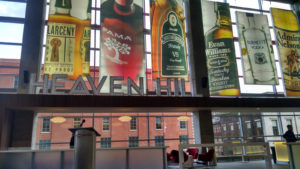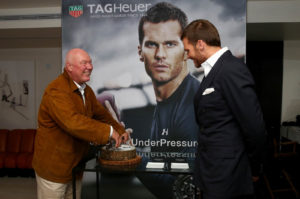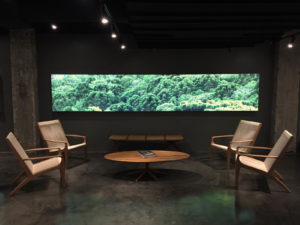
Photo: Fabric Images Inc.
Versatility, flexibility and easy handling are making Silicone Edge Graphics increasingly popular in a variety of markets.
Silicone Edge Graphics (SEG) systems have become extremely popular in the retail, exhibition and decor market segments for both frontlit and backlit applications. “Today I consider it the go-to and mainstay of showcasing brand and product marketing, due to the high-quality, non-bulky, versatile offerings that the SEG systems provide,” says Eric Tischer, president of Verseidag U.S. in Randolph, N.J. “These advantages, along with the ease of graphic change-out, make SEG the ‘go-to’ for retail and tradeshow graphics.”
SEG graphics have a silicone beading sewn to the outer side edges of the print, which is then situated into an SEG frame. Typically sewn, the panels are easy to roll up, ship and store for quick deployment. The silicone gasket fits into a track in an extruded frame, using tension.
SEG was first adopted in the trade show industry and used for large-format and grand-format signage at convention center venues. Casey Ford, president and CEO at 40 Visuals, Spring Lake, Mich., says that this change created a bolder look to signage at trade shows and facilitated an evolution in booth design that allowed for a more custom look. “Exhibitors found that not only did this new booth format stretch their marketing dollars, but it also allowed them to get more creative with their branding and show awareness,” Ford says.
As retailers, brands and other businesses at trade shows started seeing SEG in use, it started spreading to retail environments. “SEG as signage was seen in the retail environments in Europe as far back as a decade ago, but has now matured as a signage alternative here in the U.S.,” Ford says. “It is extremely prevalent in major city high street shopping areas, in malls and shopping centers across the country, and in airports.”

Interior excellence
SEG frame profiles come in a variety of thicknesses, single- or double-sided, various angles, frontlit or with LED backlighting. “The finished product offers a low profile, image-to-edge graphic that can be updated and changed out very quickly,” Tischer says.
The popularity of SEG is reaching quickly into new markets. Valerie Cuchna, material resources liaison at Fabric Images Inc. in Elgin, Ill., started off using SEG for retail wall applications, which allowed for easy change-out of graphics by untrained installers.
“It has become a standard for light boxes in trade shows and events,” Cuchna says. “For interior spaces, including commercial spaces and residential locations, it’s taking hold in the wall art arena. The need for just a perimeter frame to cover a large span makes it an attractive option for install as well as removal or change-outs of large graphic wall panels.”
A variety of extrusion profiles is available for SEG use depending on the intended application. All extrusions contain a channel that holds the graphic with a silicone gasket sewn around the edge, using tension to keep it taut. Some SEG frames are mounted to walls using simple screws or L brackets. Others are free-standing and require more bulk to maintain form, including base plates, internal bracing and tension fittings.
Fabrics, ink and printing
Fabrics are the product of choice for use in SEG frames because of their versatility and ability to stretch. Which fabrics are used often depends on the print quality needed, as well as the hand and crease-resistance of the material.
Two different ink technologies are generally used in printing SEG fabrics: dye sublimation and UV. Which is better? Ford says it depends on the individual project.
“Direct print can be printed onto fabric up to 16 feet in width, allowing larger seamless backdrops or fewer seams on an extra-large backdrop,” Ford says. Dye sublimation can only be printed onto fabric up to 10 feet wide, meaning anything bigger would require seams. However, the dye sublimation image tends to have better resolution and color vibrancy. For signage in the retail environment, dye sublimation seems to be preferred.”
Dye sublimation printing on polyester-based materials is Fabric Images’ preferred method for SEG applications. “For wall art, warp knit materials are nice since they tend to have some stretch, making it easier to apply the fabric with a smooth finish,” Cuchna says. “For backlits, there are a number of fabric options on the market. You will want to find one with a balance of light diffusion, color vibrancy when printed, price and ease of use. You will also want to avoid fabrics that have a heavy pile or significant thickness, because they will be too difficult to fit into the frame once the silicone gasket is sewn to the edge.”

Measure twice, sew once
According to Eric Tischer, print providers need to have their production and finishing departments practiced and polished to succeed and optimize SEG applications.
“Coming out of production with the exact SEG frame dimensions can be a difficult task following printing—calendering if via dye sublimation—and sewing the silicone edge in,” he says. “If sizing is off in either direction—too small or too large—this will adversely affect the end quality of fabric and image in the frame. Understanding your production and finishing is key to delivering a premium product in the first attempt, as well as repeating.”
Both printing and sewing capabilities are needed, clearly, to complete SEG projects. Valerie Cuchna notes that your team will need an understanding of how LED lighting works and will need to test out the lighting with the actual graphics, taking lighting temperature into consideration, to avoid color shift in use.
Casey Ford advises that the biggest obstacle to doing SEG graphics properly is to have the right sewing equipment and training. “Because the material used for SEG has some give to it and stretches, a consistent speed to the sewing is extremely important to provide a product that has an absolute minimal amount of puckering. A perfectly synchronized fabric finishing system like the Impulsa Synchromatic ECO NA Series is what most serious SEG printers and finishers use.”
The system of choice
SEG as signage is still in its infancy, but growth in this area has proceeded at a fast pace in the U.S. over the last few years.
“SEG signage is now being seen in department stores, malls, airports, luxury shops, hospitals and other environments,” Ford says. “Just about anywhere large signage for indoor applications exists is where we are seeing growth.”
The simplicity of the systems, as well as the ease of graphic change-out, ensures their popularity. According to Tischer, SEG is already the main choice of system for in-store retail marketing and is quickly growing in the exhibition and decor segments. As more superwide XL fabrics (15–16 feet wide) are coming onto the market, there also are expanded opportunities for grand-scale dye sublimation printed SEG pieces.
“For wall applications, a perimeter frame can handle extremely large fabric pieces, and I foresee this type of application becoming more prevalent in interior spaces as a way to apply art in a quickly deployable, easily changeable way,” Cuchna says.
“The versatility of SEG systems, as well as working for either frontlit or backlit applications, makes this product very versatile,” Tischer says. “It looks as if SEG will be the key display choice for the foreseeable future.”
Maura Keller is a freelance writer and editor based in Plymouth, Minn.
 TEXTILES.ORG
TEXTILES.ORG


